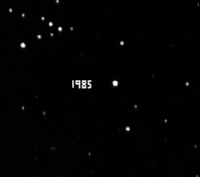
Photo from wikipedia
We present spatially resolved stellar kinematic maps, for the first time, for a sample of 17 intermediate redshift galaxies (0.2 less than or similar to z less than or similar… Click to show full abstract
We present spatially resolved stellar kinematic maps, for the first time, for a sample of 17 intermediate redshift galaxies (0.2 less than or similar to z less than or similar to 0.8). We used deep MUSE/VLT integral held spectroscopic observations in the Hubble Deep Field South (HDFS) and Hubble Ultra Deep Field (HUDF), resulting from approximate to 30 h integration time per held, each covering 1' x 1' held of view, with approximate to 0''.65 spatial resolution. We selected all galaxies brighter than 25 mag in the I band and for which the stellar continuum is detected over an area that is at least two times larger than the spatial resolution. The resulting sample contains mostly late‐type disk, main‐sequence star‐forming galaxies with 10(8.5) M circle dot less than or similar to M,less than or similar to 10(10.5) M circle dot . Using a full‐spectrum fitting technique, we derive two‐dimensional maps of the stellar and gas kinematics, including the radial velocity V and velocity dispersion sigma . We find that most galaxies in the sample are consistent with having rotating stellar disks with roughly constant velocity dispersions and that the second order velocity moments V‐rms = root V‐2 + sigma(2) of the gas and stars, a scaling proxy for the galaxy gravitational potential, compare well to each other. These spatially resolved observations of the stellar kinematics of intermediate redshift galaxies suggest that the regular stellar kinematics of disk galaxies that is observed in the local Universe was already in place 4‐7 Gyr ago and that their gas kinematics traces the gravitational potential of the galaxy, thus is not dominated by shocks and turbulent motions. Finally, we build dynamical axisymmetric Jeans models constrained by the derived stellar kinematics for two specific galaxies and derive their dynamical masses. These are in good agreement (within 25%) with those derived from simple exponential disk models based on the gas kinematics. The obtained mass‐to‐light ratios hint towards dark matter dominated systems within a few effective radii.
Journal Title: Astronomy and Astrophysics
Year Published: 2017
Link to full text (if available)
Share on Social Media: Sign Up to like & get
recommendations!